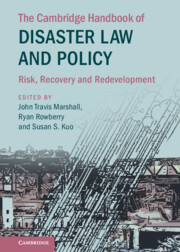Book contents
- The Cambridge Handbook of Disaster Law and Policy
- The Cambridge Handbook of Disaster Law and Policy
- Copyright page
- Dedication
- Contents
- Figures
- Maps
- Tables
- Contributors
- Foreword: Current Trends in Disaster Law and Policy
- Acknowledgments
- Introduction
- Part I Critical Perspectives on the Evolution of Disaster Law and Policy
- Part II Effective Governance as an Imperative for Responsive Disaster Law and Policy
- Part III Law’s Role in Promoting Hazard Mitigation: Intergovernmental, International, National, and Local Approaches
- Part IV Private Sector Initiatives to Promote Disaster Resilience and Recovery
- Part V Lawyers As Disaster Law and Policy Leaders: Training for Students and Guidance for Practitioners
- Part VI Cultural Heritage Protection and Cross-Disciplinary Opportunities for Advancing Disaster Law and Policy
- 26 Scheduled Monuments and Sites at Risk of Coastal Erosion: Danish Heritage Legislation and Actions
- 27 Heritage-Related Disaster Policy in the United States
- 28 Love for Heritage in the Time of Covid-19: Pandemics and Preparedness
- 29 Reflections on Urban Cultural Heritage, Public Health, and Public Participation
- Part VII Disasters and Vulnerable Communities
26 - Scheduled Monuments and Sites at Risk of Coastal Erosion: Danish Heritage Legislation and Actions
from Part VI - Cultural Heritage Protection and Cross-Disciplinary Opportunities for Advancing Disaster Law and Policy
Published online by Cambridge University Press: 27 October 2022
- The Cambridge Handbook of Disaster Law and Policy
- The Cambridge Handbook of Disaster Law and Policy
- Copyright page
- Dedication
- Contents
- Figures
- Maps
- Tables
- Contributors
- Foreword: Current Trends in Disaster Law and Policy
- Acknowledgments
- Introduction
- Part I Critical Perspectives on the Evolution of Disaster Law and Policy
- Part II Effective Governance as an Imperative for Responsive Disaster Law and Policy
- Part III Law’s Role in Promoting Hazard Mitigation: Intergovernmental, International, National, and Local Approaches
- Part IV Private Sector Initiatives to Promote Disaster Resilience and Recovery
- Part V Lawyers As Disaster Law and Policy Leaders: Training for Students and Guidance for Practitioners
- Part VI Cultural Heritage Protection and Cross-Disciplinary Opportunities for Advancing Disaster Law and Policy
- 26 Scheduled Monuments and Sites at Risk of Coastal Erosion: Danish Heritage Legislation and Actions
- 27 Heritage-Related Disaster Policy in the United States
- 28 Love for Heritage in the Time of Covid-19: Pandemics and Preparedness
- 29 Reflections on Urban Cultural Heritage, Public Health, and Public Participation
- Part VII Disasters and Vulnerable Communities
Summary
Denmark is a lowland country with a coastline of more than 7,000 kilometers. The Danish coastal zone contains a rich archaeological heritage, which is vital for understanding the development of the Southwestern Scandinavian area, and its changing prehistoric and historic communities. However, the ongoing climate change and its environmental consequences poses a threat to some of the country’s 32,000 scheduled monuments and sites. Danish legislation on monuments is restrictive: the default position is that no changes at all may be made to historic monuments and sites. The issue of monuments and sites threatened by coastal erosion is interesting in that society has instituted a conservation system that cannot be sustained because of escalating weather conditions. This poses major administrative challenges to the country’s cultural heritage authorities, who need to re-evaluate some quite fundamental concepts and principles of current cultural heritage practices. Above all, this means breaking with a long-standing management tradition that needs to be better adapted to tackle the future challenges of cultural heritage in a world of global warming.
- Type
- Chapter
- Information
- The Cambridge Handbook of Disaster Law and PolicyRisk, Recovery, and Redevelopment, pp. 423 - 435Publisher: Cambridge University PressPrint publication year: 2022



